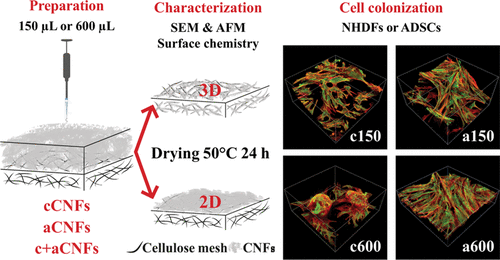当前位置:
X-MOL 学术
›
Biomacromolecules
›
论文详情
Our official English website, www.x-mol.net, welcomes your
feedback! (Note: you will need to create a separate account there.)
Cellulose Mesh with Charged Nanocellulose Coatings as a Promising Carrier of Skin and Stem Cells for Regenerative Applications
Biomacromolecules ( IF 5.5 ) Pub Date : 2020-11-02 , DOI: 10.1021/acs.biomac.0c01097 Julia Pajorova 1, 2 , Anne Skogberg 3 , Daniel Hadraba 4 , Antonin Broz 1 , Martina Travnickova 1, 2 , Marketa Zikmundova 1 , Mari Honkanen 5 , Markus Hannula 3 , Panu Lahtinen 6 , Maria Tomkova 7 , Lucie Bacakova 1 , Pasi Kallio 3
Biomacromolecules ( IF 5.5 ) Pub Date : 2020-11-02 , DOI: 10.1021/acs.biomac.0c01097 Julia Pajorova 1, 2 , Anne Skogberg 3 , Daniel Hadraba 4 , Antonin Broz 1 , Martina Travnickova 1, 2 , Marketa Zikmundova 1 , Mari Honkanen 5 , Markus Hannula 3 , Panu Lahtinen 6 , Maria Tomkova 7 , Lucie Bacakova 1 , Pasi Kallio 3
Affiliation

|
Engineering artificial skin constructs is an ongoing challenge. An ideal material for hosting skin cells is still to be discovered. A promising candidate is low-cost cellulose, which is commonly fabricated in the form of a mesh and is applied as a wound dressing. Unfortunately, the structure and the topography of current cellulose meshes are not optimal for cell growth. To enhance the surface structure and the physicochemical properties of a commercially available mesh, we coated the mesh with wood-derived cellulose nanofibrils (CNFs). Three different types of mesh coatings are proposed in this study as a skin cell carrier: positively charged cationic cellulose nanofibrils (cCNFs), negatively charged anionic cellulose nanofibrils (aCNFs), and a combination of these two materials (c+aCNFs). These cell carriers were seeded with normal human dermal fibroblasts (NHDFs) or with human adipose-derived stem cells (ADSCs) to investigate cell adhesion, spreading, morphology, and proliferation. The negatively charged aCNF coating significantly improved the proliferation of both cell types. The positively charged cCNF coating significantly enhanced the adhesion of ADSCs only. The number of NHDFs was similar on the cCNF coatings and on the noncoated pristine cellulose mesh. However, the three-dimensional (3D) structure of the cCNF coating promoted cell survival. The c+aCNF construct proved to combine benefits from both types of CNFs, which means that the c+aCNF cell carrier is a promising candidate for further application in skin tissue engineering.
中文翻译:

带电荷的纳米纤维素涂层的纤维素网作为有希望的皮肤和干细胞再生载体
工程化人造皮肤构造是一个持续的挑战。容纳皮肤细胞的理想材料仍有待发现。低成本纤维素是有希望的候选者,其通常以网状形式制造并用作伤口敷料。不幸的是,当前的纤维素网的结构和形貌对于细胞生长而言并不是最佳的。为了增强市售网片的表面结构和理化特性,我们用木材衍生的纤维素纳米原纤维(CNF)涂覆了网片。在这项研究中,提出了三种不同类型的网状涂层作为皮肤细胞载体:带正电的阳离子纤维素纳米原纤维(cCNF),带负电的阴离子纤维素纳米原纤维(aCNF)以及这两种材料的组合(c + aCNF)。这些细胞载体接种了正常的人类真皮成纤维细胞(NHDFs)或人类脂肪来源的干细胞(ADSCs),以研究细胞的粘附,扩散,形态和增殖。带负电荷的aCNF涂层可显着改善两种细胞类型的增殖。带正电荷的cCNF涂层仅显着增强了ADSC的附着力。在cCNF涂层和未涂层的原始纤维素网上,NHDF的数量相似。但是,cCNF涂层的三维(3D)结构促进了细胞存活。事实证明,c + aCNF构建体结合了两种类型CNF的优势,这意味着c + aCNF细胞载体是在皮肤组织工程中进一步应用的有希望的候选者。扩散,形态和扩散。带负电荷的aCNF涂层可显着改善两种细胞类型的增殖。带正电荷的cCNF涂层仅显着增强了ADSC的附着力。在cCNF涂层和未涂层的原始纤维素网上,NHDF的数量相似。但是,cCNF涂层的三维(3D)结构促进了细胞存活。事实证明,c + aCNF构建体结合了两种类型CNF的优势,这意味着c + aCNF细胞载体是在皮肤组织工程中进一步应用的有希望的候选者。扩散,形态和扩散。带负电荷的aCNF涂层可显着改善两种细胞类型的增殖。带正电荷的cCNF涂层仅显着增强了ADSC的附着力。在cCNF涂层和未涂层的原始纤维素网上,NHDF的数量相似。但是,cCNF涂层的三维(3D)结构促进了细胞存活。事实证明,c + aCNF构建体结合了两种类型CNF的优势,这意味着c + aCNF细胞载体是在皮肤组织工程中进一步应用的有希望的候选者。在cCNF涂层和未涂层的原始纤维素网上,NHDF的数量相似。但是,cCNF涂层的三维(3D)结构促进了细胞存活。事实证明,c + aCNF构建体结合了两种类型CNF的优势,这意味着c + aCNF细胞载体是在皮肤组织工程中进一步应用的有希望的候选者。在cCNF涂层和未涂层的原始纤维素网上,NHDF的数量相似。但是,cCNF涂层的三维(3D)结构促进了细胞存活。事实证明,c + aCNF构建体结合了两种类型CNF的优势,这意味着c + aCNF细胞载体是在皮肤组织工程中进一步应用的有希望的候选者。
更新日期:2020-12-14
中文翻译:

带电荷的纳米纤维素涂层的纤维素网作为有希望的皮肤和干细胞再生载体
工程化人造皮肤构造是一个持续的挑战。容纳皮肤细胞的理想材料仍有待发现。低成本纤维素是有希望的候选者,其通常以网状形式制造并用作伤口敷料。不幸的是,当前的纤维素网的结构和形貌对于细胞生长而言并不是最佳的。为了增强市售网片的表面结构和理化特性,我们用木材衍生的纤维素纳米原纤维(CNF)涂覆了网片。在这项研究中,提出了三种不同类型的网状涂层作为皮肤细胞载体:带正电的阳离子纤维素纳米原纤维(cCNF),带负电的阴离子纤维素纳米原纤维(aCNF)以及这两种材料的组合(c + aCNF)。这些细胞载体接种了正常的人类真皮成纤维细胞(NHDFs)或人类脂肪来源的干细胞(ADSCs),以研究细胞的粘附,扩散,形态和增殖。带负电荷的aCNF涂层可显着改善两种细胞类型的增殖。带正电荷的cCNF涂层仅显着增强了ADSC的附着力。在cCNF涂层和未涂层的原始纤维素网上,NHDF的数量相似。但是,cCNF涂层的三维(3D)结构促进了细胞存活。事实证明,c + aCNF构建体结合了两种类型CNF的优势,这意味着c + aCNF细胞载体是在皮肤组织工程中进一步应用的有希望的候选者。扩散,形态和扩散。带负电荷的aCNF涂层可显着改善两种细胞类型的增殖。带正电荷的cCNF涂层仅显着增强了ADSC的附着力。在cCNF涂层和未涂层的原始纤维素网上,NHDF的数量相似。但是,cCNF涂层的三维(3D)结构促进了细胞存活。事实证明,c + aCNF构建体结合了两种类型CNF的优势,这意味着c + aCNF细胞载体是在皮肤组织工程中进一步应用的有希望的候选者。扩散,形态和扩散。带负电荷的aCNF涂层可显着改善两种细胞类型的增殖。带正电荷的cCNF涂层仅显着增强了ADSC的附着力。在cCNF涂层和未涂层的原始纤维素网上,NHDF的数量相似。但是,cCNF涂层的三维(3D)结构促进了细胞存活。事实证明,c + aCNF构建体结合了两种类型CNF的优势,这意味着c + aCNF细胞载体是在皮肤组织工程中进一步应用的有希望的候选者。在cCNF涂层和未涂层的原始纤维素网上,NHDF的数量相似。但是,cCNF涂层的三维(3D)结构促进了细胞存活。事实证明,c + aCNF构建体结合了两种类型CNF的优势,这意味着c + aCNF细胞载体是在皮肤组织工程中进一步应用的有希望的候选者。在cCNF涂层和未涂层的原始纤维素网上,NHDF的数量相似。但是,cCNF涂层的三维(3D)结构促进了细胞存活。事实证明,c + aCNF构建体结合了两种类型CNF的优势,这意味着c + aCNF细胞载体是在皮肤组织工程中进一步应用的有希望的候选者。











































 京公网安备 11010802027423号
京公网安备 11010802027423号